Select the ![]() Bookmarks tab to work with bookmarks.
Bookmarks tab to work with bookmarks.
There are several ways to add bookmarks to a document manually. These bookmarks always, by default, link to the current view of the page that is active in the main workspace at the time of their creation
 arrow to the right of the
arrow to the right of the Right-click any bookmark, then go to Add and select any of the above actions to place a new bookmark relative to it.
When a bookmark is added manually, it is automatically named after the page's label.
There are
Bookmarks can be created automatically using PDF page labels or the text contained within a defined a region of a PDF.
To automatically create bookmarks:
 Bookmarks or press ALT+B to open the
Bookmarks or press ALT+B to open the  Bookmarks tab.
Bookmarks tab.Click ![]() Create Bookmarks. The Create Bookmarks dialog box appears.
Create Bookmarks. The Create Bookmarks dialog box appears.
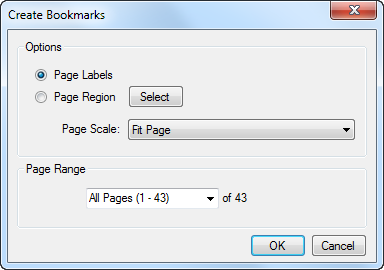
Page Region: Select to create bookmarks using text within a defined region. To define the region:
Click and drag to define a region on the PDF. Generally speaking, the data in this region should be located in the same place on each PDF. When the region has been defined, the AutoMark dialog box appears.
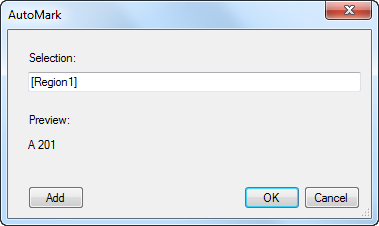
Note: AutoMark is most suitable for documents that are vector-based, are the same size and have the same registration. AutoMark might not work as expected if the pages are different sizes, if some of the pages are not searchable or if the scans are not properly registered.
To select a Page Range, click the Pages menu and select from the following:
For example: 1-3, 5, 9 will include pages 1, 2, 3, 5 and 9.
Action controls what happens when a bookmark is clicked. To define the action of a specific bookmark:
 Bookmarks or press ALT+B to open the
Bookmarks or press ALT+B to open the  Bookmarks tab.
Bookmarks tab.Alternatively, right-click the desired bookmark and select Action.
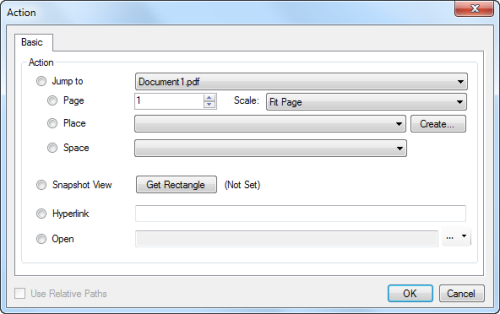
There are
Jump to Page: Moves to a specific page number in a selected PDF. To set this action:
Jump to Place: Moves to a predefined Place on a PDF. The location of a Place can be changed later without breaking the action. To set this action:
Jump to Space: Moves to a predefined Space on a PDF. To set this action:
Note: If an Action is set to jump to a Space that is subsequently deleted, the Action will be automatically converted to Snapshot View, as described below.
Snapshot View: Moves to a specific, zoomed in area of the current PDF. This option is useful for zooming into specific views of a region of a large format drawing, such as a particular elevation detail. Click Get Rectangle to define the area of the drawing to jump to.
Hyperlink: Opens the URL entered in the Hyperlink field. The URL will open in
Open: Opens the file specified in the Open File field. Click  button
button
Use Relative Paths: Revu can store either a full or relative path to a file. When a full path is stored, the location of the file is defined from the drive it resides on; when a relative path is stored, it defines the location of the linked file relative to the current file. A full path is best when you plan to move the file storing the link but not the file being linked to, such as when the linked file resides on a network drive that is accessible to all users. A relative path is best when both files are liable to be moved, such as when you are archiving an entire project to CD, or moving a project to another computer. For more information and Relative vs Full Path, see Understanding Relative vs Full Paths.
Bookmarks can be reordered by simply clicking and dragging them to the desired location. Hold down SHIFT or CTRL to select multiple bookmarks. As the bookmark is being moved, a line appears indicating the position the bookmark will be placed.
To make a bookmark a child of another bookmark, drag it inward. The line will indent to show that the bookmark will be made as a child, or subordinate, of the main bookmark.
Bookmark Properties determines it appearance in the Bookmarks list. To change a bookmark's Properties:
 Bookmarks or press ALT+B to open the
Bookmarks or press ALT+B to open the  Bookmarks tab.
Bookmarks tab.Alternatively, right-click a bookmark and select ![]() Properties.
Properties.
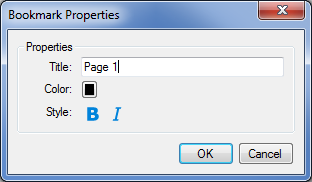
The following properties are changeable:
Title: Specifies the name of the bookmark as it will appear in the Bookmarks list.
Color: Sets the font color for the bookmark name in the Bookmarks list.
Style: Formats the bookmark name's font as Bold or Italic.
To create a copy of a bookmark, select it, hold down the CTRL key, then drag and drop it to a new position in the Bookmarks list. The cursor under the dragged bookmark will include a small "+" when a bookmark is being copied.
There are three ways to rename a bookmark:
There are three ways to change the Action of the bookmark:
Click ![]() Audit Bookmarks to determine whether bookmarks are broken. A bookmark is considered broken if the Action points to a page that is no longer in the current PDF. It is a good idea to audit the bookmarks after PDF combine operations have been performed.
Audit Bookmarks to determine whether bookmarks are broken. A bookmark is considered broken if the Action points to a page that is no longer in the current PDF. It is a good idea to audit the bookmarks after PDF combine operations have been performed.
After the audit is complete, a dialog box will appear and report how many broken bookmarks have been found.

Then a red X will display to the left of a broken bookmark. Either delete the bookmark or change the Action to point to a valid page.

Bookmarks in one or more PDFs can be exported to a CSV or PDF file. These bookmark reports can contain just top-level bookmarks or all bookmarks and can be presented in different styles.
 Bookmarks or press ALT+B to open the
Bookmarks or press ALT+B to open the  Bookmarks tab.
Bookmarks tab.Click ![]() Export Bookmarks on the Bookmarks toolbar. The Export Bookmarks dialog box appears.
Export Bookmarks on the Bookmarks toolbar. The Export Bookmarks dialog box appears.
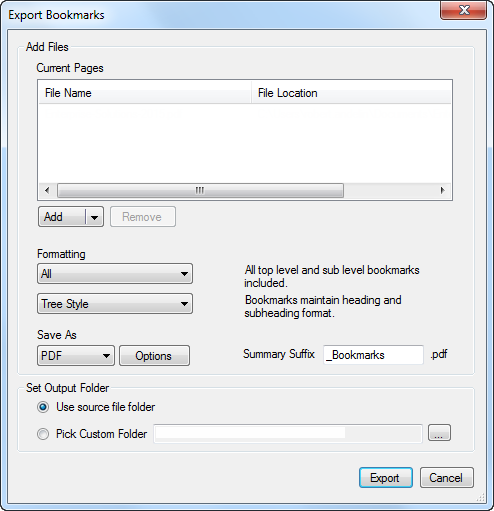
The active PDF (if any) will be automatically added to the Current Pages list. To add more PDFs to the list, select one of the following options from the Add list:
There are different save options available for each format type. Click Options to edit them:
Create Hyperlinks: When enabled, the export file will include hyperlinks to the source pages.
Note: Bookmark exports generated from PDFs hosted in a Studio Session will not include hyperlinks.
Include Hyperlinks: When enabled, the export file will include hyperlinks to the source pages.
Note: Bookmark exports generated from PDFs hosted in a Studio Session will not include hyperlinks.